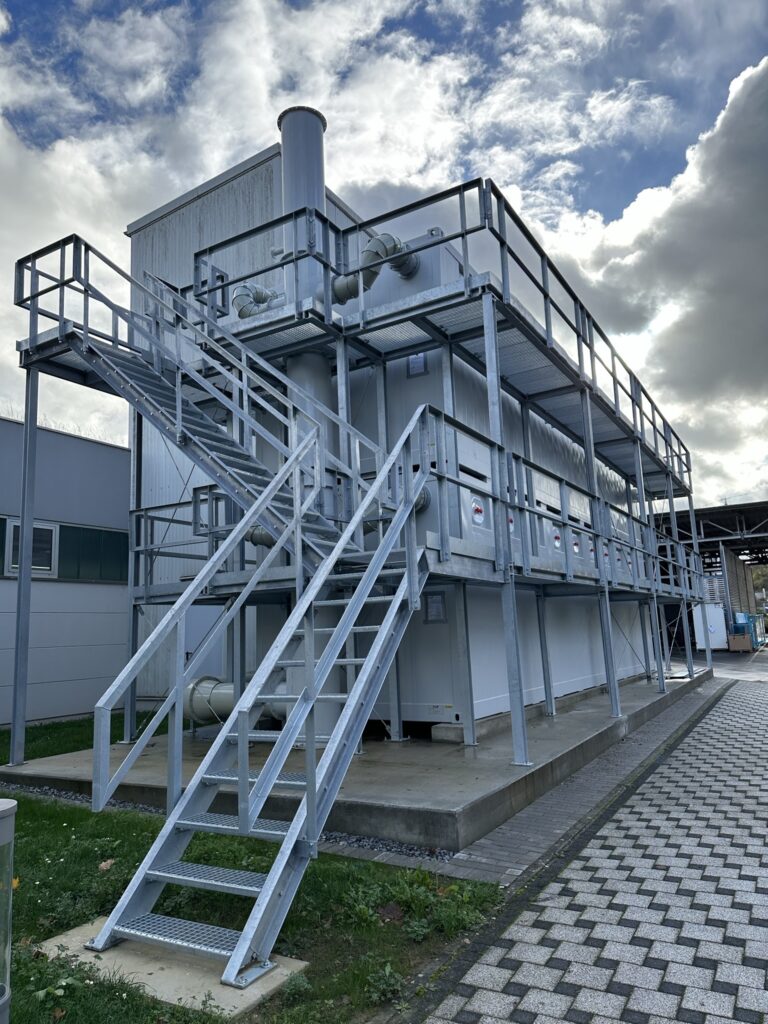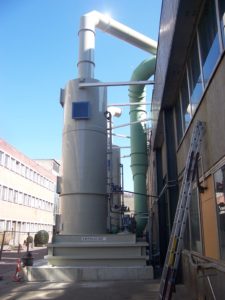
PlasmaAir AG supplies turnkey systems for the purification of polluted exhaust air flows from industrial plants.
Each system is individually designed. For this purpose, the volume flow and the air constituents must be known.
In order to achieve process reliability when designing the system, preliminary tests can be carried out using pilot plants. For this purpose, a suitable test system is put together and the tests are accompanied by measurement technology.
PlasmaAir concentrates on special applications and gaseous substances.
The size of the system is adapted to the volume flow of pollutants. So far, plants of 100-100,000 Bm³/h hour have been realized. The systems are installed and commissioned on a turnkey basis (including separator, fan, switchgear, piping and blow-out stack).
Application
Absorption scrubbers are used to reduce gaseous contaminants. Absorbable pollutants are mostly inorganic compounds such as ammonia NH3: Ammonia NH3, hydrogen sulphide H2S, hydrogen chloride HCl, sulphur dioxide SO2, amines, etc.
A distinction is made between physical and chemical absorption. In chemical absorption, the pollutant is bound by adding lye or acid. The same types of system are used for both processes; in the case of chemical absorption, the system is expanded to include pH value stabilization.
Typical areas of application:
– Exhaust air from galvanic plants – Pollutants: HCl, NH3, …
– Exhaust air from core shooters – pollutants: amines, SO3
– Exhaust air from semiconductor production – pollutants: HCl, NH3, SiH4
– Exhaust air from sewage treatment plants – pollutants: H2S, NH3
– Exhaust air from cleaning systems
The exhaust air flows from the production processes are cleaned in absorption scrubbers from the harmful gases on the basis of the solubility of the harmful gases in scrubbing liquids.
The exhaust air flows from the production processes are cleaned of the harmful gases in absorption scrubbers based on the solubility of the harmful gases in scrubbing liquids.
The scrubbing liquids used are adapted to the respective pollutant in order to achieve optimum efficiency. The absorption scrubbers are designed as spray scrubbers (nozzle scrubbers) or as packed scrubbers. The design can be horizontal or vertical.
In addition to water as an absorbent, weak acids (e.g. sulphuric acid) or alkaline solutions (caustic soda) are used. The systems are pH value controlled. The pH value is kept stable by adding concentrated acid (lye). The dosing systems and the pH value measurements are integrated in the system technology.
The fill levels are kept constant by adding water. The water exchange can take place automatically, e.g. via a concentration measurement.
PlasmaAir AG offers vertical packed scrubbers as standard. Each scrubber or exhaust air system is adapted to the volume flow and the pollutant content in terms of process technology.
Absorption scrubbers are used to reduce gaseous contaminants. Absorbable pollutants are mostly inorganic compounds such as ammonia NH3: Ammonia NH3, hydrogen sulphide H2S, hydrogen chloride HCl, sulphur dioxide SO2, amines, etc.
A distinction is made between physical and chemical absorption. In chemical absorption, the pollutant is bound by adding lye or acid. The same types of system are used for both processes; in the case of chemical absorption, the system is expanded to include pH value stabilization.
Typical areas of application:
– Exhaust air from galvanic plants – Pollutants: HCl, NH3, …
– Exhaust air from core shooters – pollutants: amines, SO3
– Exhaust air from semiconductor production – pollutants: HCl, NH3, SiH4
– Exhaust air from sewage treatment plants – pollutants: H2S, NH3
– Exhaust air from cleaning systems
The exhaust air flows from the production processes are cleaned in absorption scrubbers from the harmful gases on the basis of the solubility of the harmful gases in scrubbing liquids.
The exhaust air flows from the production processes are cleaned of the harmful gases in absorption scrubbers based on the solubility of the harmful gases in scrubbing liquids.
The scrubbing liquids used are adapted to the respective pollutant in order to achieve optimum efficiency. The absorption scrubbers are designed as spray scrubbers (nozzle scrubbers) or as packed scrubbers. The design can be horizontal or vertical.
In addition to water as an absorbent, weak acids (e.g. sulphuric acid) or alkaline solutions (caustic soda) are used. The systems are pH value controlled. The pH value is kept stable by adding concentrated acid (lye). The dosing systems and the pH value measurements are integrated in the system technology.
The fill levels are kept constant by adding water. The water exchange can take place automatically, e.g. via a concentration measurement.
PlasmaAir AG offers vertical packed scrubbers as standard. Each scrubber or exhaust air system is adapted to the volume flow and the pollutant content in terms of process technology.
In the case of cleaning systems or alcohol coatings and the use of isopropanol or ethanol, clean gas values above the legally prescribed limit of 50 mg/m3 must be reduced.
With our newly developed scrubber type DB, the limit values are complied with at lowest water consumption.
This new type of scrubber – the sieve tray scrubber – was developed and qualified especially for cleaning exhaust air loaded with alcohols.
Advantages of the sieve tray scrubber:
- no water circulation pump
- low investment costs
- low operating costs
- the waste water can be discharged directly into the sewage treatment plant (discharge limit 2 g/l)
- low maintenance costs
In addition to the low-cost construction, another advantage of this system concept is that the lead time and the follow-up time are very short. This means that the plants can be switched on or off as required.
In principle, it is possible to build the scrubbers from plastic, stainless steel as well as steel, thus taking into account corrosion aspects.
The major advantages of a wet separator are its unsurpassed robustness and maintainability, as well as process-related advantages when it comes to separating gaseous particles or conditioning the cleaned air in certain processes.
Dust Collector
Venturi dust collectors and vortex scrubbers provide highly efficient, low-maintenance separation of dusts when processing fire- and explosion-hazardous materials.
The operating principle of wet separation
The particles dispersed in the gas stream are brought into contact with a scrubbing liquid in order to bind them therein. For this purpose, the largest possible phase interface must be created between the gas (air) and the liquid. A flow deflection of the gas takes place. Due to the mass inertia, the particles move towards the liquid surface and are bound or deposited there.
The advantages of the wet separator for dust:
- operation without filter elements
- safest solution for processing fire and explosive materials
- suitable for many applications
- high separation efficiency with highest operational safety
- low maintenance
A biofilter is an exhaust air purification process for the treatment of water-soluble, microbiologically degradable airborne substances. In contrast to other processes, biological oxidation – i.e. elimination of the pollutants – does not result in any disposal costs for the pollutants concentrated in the filter.
Biofilters have proven to be an economical and reliable system for the elimination of organic hydrocarbons and odour-intensive pollutants, especially for large exhaust air volume flows. Large systems are primarily designed as surface filters or as stackable individual modules. In contrast to the lower investment costs when using a panel filter, there is a higher operational reliability as well as a lower footprint requirement with the container filter, since the bed is protected from disturbing environmental influences and the relatively small surface unit can be influenced with regard to the homogeneous flow. A much greater advantage lies in the simple expandability of corresponding systems, through the possibility of stacking the individual modules. Depending on the area of application, the exhaust air must be conditioned before entering the biofilter. For this purpose, special scrubbers are used to cover areas such as grease separation, dust separation, temperature control and humidification.
Pilot tests can be carried out with our mobile test plant prior to plant design. The aim of these tests is the optimal adaptation to customer-specific requirements.
In our environmental analysis department we are available for all questions of measurement technology in the field of polluted exhaust gases. We have both the expertise and the necessary equipment to perform accurate measurements of your exhaust parameters.
This ranges from the recording of physical data to chemical composition and trace analysis. These measurements are the basis for the optimal design of an exhaust air purification plant. We will also be pleased to provide you with expert assistance in the conceptual design of such a system.
Our spectrum of analytics includes both gas and dust measurements.
The following measurement methods are available to you:
- Dust, soot and oil mist determination according to VDI guidelines 2066 in flowing gases
- Fractionated dust measurement
- Measurement of total hydrocarbons in the exhaust air stream by means of FID
- GC/GCMS analysis to determine the composition of exhaust air
- Measurement and evaluation of odoors, olfactometry
- Sound measurement at plants according to VDI guideline
- Germ count determination

